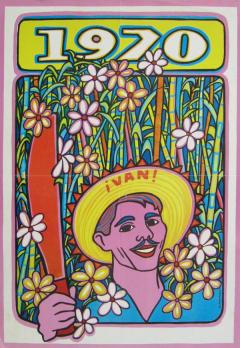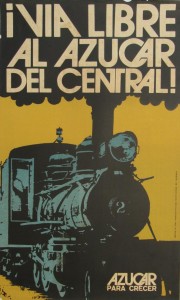 Azúcar (Sugar) has been on display since January 10th at the gallery of the “Rubén Martínez Villena” Public Library (located at Plaza de Armas) in Old Havana, Cuba. As Rafael Grillo writes in his review (“Recovering Sugar”), “It brings together a sample of the visual display that accompanied the epic of the machete and the tasks of the sugar mill during the 1960s, 1970s and 1980s in Cuba.”
Azúcar (Sugar) has been on display since January 10th at the gallery of the “Rubén Martínez Villena” Public Library (located at Plaza de Armas) in Old Havana, Cuba. As Rafael Grillo writes in his review (“Recovering Sugar”), “It brings together a sample of the visual display that accompanied the epic of the machete and the tasks of the sugar mill during the 1960s, 1970s and 1980s in Cuba.”
“Cane that remains… sugar that is lost,” cautions a poster from 1986 that reminds us of a still recent past, when the planting of sugar-cane fields, the sugar mill and the grinding of cane were the productive soul of the Cuban nation.
Azúcar (Sugar) has been on display since January 10th at the gallery of the “Rubén Martínez Villena” Public Library (situated on Plaza de Armas, Habana Vieja). Under that title, it brings together a sample of the visual display that accompanied the epic of the machete and the tasks of the sugar mill during the 1960s, 1970s and 1980s in Cuba.
There are twenty-nine posters, several from unidentified authors and others signed by Cuban graphic artists such as Salvador Corratgé, Raúl Martínez, José Papiol, Daysi García López, Humberto Trujillo Pardo, Jesús Forjans, René Mederos and Juan Antonio Gómez (Tito), among others. It is also worth mentioning the poster made by Laura Llópiz promoting the exposition.
The necessary recovery of this material would not have been possible without the passion for collecting of Damián Viñuela, the curatorial support of Michel Corría and Pepe Menéndez, and the support of Casa de las Américas and the Historian’s Office of the City of Havana.
 This exhibition seems to follow the tendency expressed in the last years to bring forth what was for over two centuries the predominant exploit of the Cuban economy and which has gone downhill in the last two decades. Azúcar joins the documentary de Moler (2004) by Alejandro Ramírez and the fiction film Melaza(2013) by Carlos Lechuga, as an exercise against forgetfulness and the consolidation of historical memory.
This exhibition seems to follow the tendency expressed in the last years to bring forth what was for over two centuries the predominant exploit of the Cuban economy and which has gone downhill in the last two decades. Azúcar joins the documentary de Moler (2004) by Alejandro Ramírez and the fiction film Melaza(2013) by Carlos Lechuga, as an exercise against forgetfulness and the consolidation of historical memory.
Passing before our eyes is the remembrance of a tragic feat because of its lack of accomplishment, that of the Ten Million Harvest. Included is the recurrent appeal to conscience, efficiency and quality and the search for the productive impulse through persuasion and enthusiasm, characteristic of the propaganda of an entire epoch. The major usefulness of this exhibition does not reside in the refuge of nostalgia for the generations that lived it, but in offering valuable information for the very young who do not know it.
It also encourages the recognition of the implicit artistic values in a production. Contrary to the simple circumstantial interest of its messages, this expressed itself through a diversity of styles (from the realism of photography to the influence of pop or the geometric line) and in the rigor obtained from the knowledge of basic graphic principles, to benefit from the drawing, the use of colour and the handling of typographies.
For original article, see http://www.cubanow.net/articles/recovering-sugar
